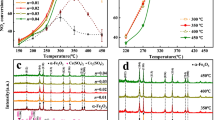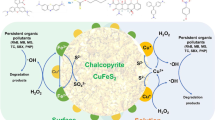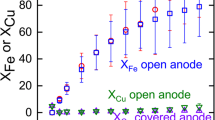Abstract
Natural minerals receive growing attention as inexpensive, green, and efficient catalysts for degradation of organic pollutants. Mechanical activation of natural chalcopyrite was conducted for improving the catalytic performance. Tetracycline degradation was evaluated in the presence of hydrogen peroxide and mechanically activated chalcopyrite. Tetracycline degradation at 100 min is 55.52% (Chp10), 68.97% (Chp30), 77.79% (Chp60), and 86.43% (Chp120), respectively, and the rate constant of pseudo-first-order kinetics is 0.0079, 0.0109, 0.0137 and 0.0192 min−1, respectively. Chalcopyrite samples were examined by multiple characterizations. Mechanical activation of natural chalcopyrite induces the decline of particle size and slight increase of surface area, smaller grain size, lattice strain, and partial sulfur oxidation. The relationship between catalytic activity and property change manifests that the improved catalytic ability is mainly ascribed to the increase of surface area and surface oxidation induced by mechanical activation. This work provides novel insights into the improvement of catalytic performance of natural minerals by mechanical activation.
摘要
废水中有机污染物是环境领域亟待解决的难题之一,非均相高级氧化工艺是降解有机污染物的高效方法,然而,非均相高级氧化工艺受限于高效催化剂的开发。天然矿物具有廉价、资源丰富、环境友好等优点,用于非均相Fenton 催化降解废水中有机污染物受到越来越多的关注。天然矿物的催化活性较低、如何提高天然矿物的催化活性是亟待解决的问题。本文提出机械活化提高天然黄铜矿的催化性能,通过非均相Fenton 降解四环素评估催化活性变化。球磨10、30、60 和120 min 的天然黄铜矿对四环素的降解率分别为55.52%、68.97%、77.79% 和86.43%,反应速率常数分别为0.0079、0.0109、0.0137 和0.0192 min−1,表明机械活化能显著提高天然黄铜矿的催化性能。通过表征分析发现,机械活化使黄铜矿的颗粒减小、比表面积增加、晶格尺寸减小、晶格畸变以及表面硫氧化。通过分析催化活性与黄铜矿不同参数的线性关系表明,催化活性提高主要归因于机械活化造成的比表面积增加与表面氧化。本研究表明机械活化能够提高天然矿物的催化活性,为开发天然矿物基高效非均相Fenton 催化剂提供新的见解。
Similar content being viewed by others
References
GARCÍA J, GARCÍA-GALÁN M J, DAY J W, et al. A review of emerging organic contaminants (EOCs), antibiotic resistant bacteria (ARB), and antibiotic resistance genes (ARGs) in the environment: Increasing removal with wetlands and reducing environmental impacts [J]. Bioresource Technology, 2020, 307: 123228. DOI: https://doi.org/10.1016/j.biortech.2020.123228.
AWAD A M, SHAIKH S M R, JALAB R, et al. Adsorption of organic pollutants by natural and modified clays: A comprehensive review [J]. Separation and Purification Technology, 2019, 228: 115719. DOI: https://doi.org/10.1016/j.seppur.2019.115719.
ZHAO Chuan-liang, ZHOU Jun-yuan, YAN Yi, et al. Application of coagulation/flocculation in oily wastewater treatment: A review [J]. Science of the Total Environment, 2021, 765: 142795. DOI: https://doi.org/10.1016/j.scitotenv.2020.142795.
PAN Zong-lin, SONG Cheng-wen, LI Lin, et al. Membrane technology coupled with electrochemical advanced oxidation processes for organic wastewater treatment: Recent advances and future prospects [J]. Chemical Engineering Journal, 2019, 376: 120909. DOI: https://doi.org/10.1016/j.cej.2019.01.188.
WANG Chong-qing, SUN Rui-rui, HUANG Rong, et al. Superior Fenton-like degradation of tetracycline by iron loaded graphitic carbon derived from microplastics: Synthesis, catalytic performance, and mechanism [J]. Separation and Purification Technology, 2021, 270: 118773. DOI: https://doi.org/10.1016/j.seppur.2021.118773.
ZHAO Ling, LIN Zhi-rong, MA Xiao-hong, et al. Catalytic activity of different iron oxides: Insight from pollutant degradation and hydroxyl radical formation in heterogeneous Fenton-like systems [J]. Chemical Engineering Journal, 2018, 352: 343–351. DOI: https://doi.org/10.1016/j.cej.2018.07.035.
KAKAVANDI B, TAKDASTAN A, POURFADAKARI S, et al. Heterogeneous catalytic degradation of organic compounds using nanoscale zero-valent iron supported on kaolinite: Mechanism, kinetic and feasibility studies [J]. Journal of the Taiwan Institute of Chemical Engineers, 2019, 96: 329–340. DOI: https://doi.org/10.1016/j.jtice.2018.11.027.
JOSEPH J, IFTEKHAR S, SRIVASTAVA V, et al. Iron-based metal-organic framework: Synthesis, structure and current technologies for water reclamation with deep insight into framework integrity [J]. Chemosphere, 2021, 284: 131171. DOI: https://doi.org/10.1016/j.chemosphere.2021.131171.
SOUFI A, HAJJAOUI H, ELMOUBARKI R, et al. Spinel ferrites nanoparticles: Synthesis methods and application in heterogeneous Fenton oxidation of organic pollutants—A review [J]. Applied Surface Science Advances, 2021, 6: 100145. DOI: https://doi.org/10.1016/j.apsadv.2021.100145.
IOFFE M, KUNDU S, PEREZ-LAPID N, et al. Heterogeneous Fenton catalyst based on clay decorated with nano-sized amorphous iron oxides prevents oxidant scavenging through surface complexation [J]. Chemical Engineering Journal, 2022, 433: 134609. DOI: https://doi.org/10.1016/j.cej.2022.134609.
AYOUB H, ROQUES-CARMES T, POTIER O, et al. Iron-impregnated zeolite catalyst for efficient removal of micropollutants at very low concentration from Meurthe River [J]. Environmental Science and Pollution Research, 2018, 25(35): 34950–34967. DOI: https://doi.org/10.1007/s11356-018-1214-0.
RAJI M, MIRBAGHERI S A, YE Fei, et al. Nano zero-valent iron on activated carbon cloth support as Fenton-like catalyst for efficient color and COD removal from melanoidin wastewater [J]. Chemosphere, 2021, 263: 127945. DOI: https://doi.org/10.1016/j.chemosphere.2020.127945.
YANG Wu, HONG Pei-dong, YANG Dan-dan, et al. Enhanced Fenton-like degradation of sulfadiazine by single atom iron materials fixed on nitrogen-doped porous carbon [J]. Journal of Colloid and Interface Science, 2021, 597: 56–65. DOI: https://doi.org/10.1016/j.jcis.2021.03.168.
GHIME D, MAHAJAN J, GHOSH P. Decoloration of Orange G by mineral hematite catalyzed Fenton-like process [J]. Environmental Engineering Science, 2016: ees.2015.0534. DOI: https://doi.org/10.1089/ees.2015.0534.
MUNOZ M, CONDE J, de PEDRO Z M, et al. Antibiotics abatement in synthetic and real aqueous matrices by H2O2/natural magnetite [J]. Catalysis Today, 2018, 313: 142–147. DOI: https://doi.org/10.1016/j.cattod.2017.10.032.
ZHANG Ya-qing, CHEN Tian-hu, ZHAO Yue-ling, et al. Catalytic effect of siderite on H2O2 oxidation of carmine dye: Performance, mechanism and kinetics [J]. Applied Geochemistry, 2019, 106: 26–33. DOI: https://doi.org/10.1016/j.apgeochem.2019.04.022.
WANG Chong-qing, SUN Rui-rui, HUANG Rong, et al. A novel strategy for enhancing heterogeneous Fenton degradation of dye wastewater using natural pyrite: Kinetics and mechanism [J]. Chemosphere, 2021, 272: 129883. DOI: https://doi.org/10.1016/j.chemosphere.2021.129883.
HUANG Xiao-tao, ZHU Tong-he, DUAN Wei-jian, et al. Comparative studies on catalytic mechanisms for natural chalcopyrite-induced Fenton oxidation: Effect of chalcopyrite type [J]. Journal of Hazardous Materials, 2020, 381: 120998. DOI: https://doi.org/10.1016/j.jhazmat.2019.120998.
DROGUETT C, SALAZAR R, BRILLAS E, et al. Treatment of antibiotic cephalexin by heterogeneous electrochemical Fenton-based processes using chalcopyrite as sustainable catalyst [J]. Science of the Total Environment, 2020, 740: 140154. DOI: https://doi.org/10.1016/j.scitotenv.2020.140154.
CHELGANI S C, PARIAN M, PARAPARI P S, et al. A comparative study on the effects of dry and wet grinding on mineral flotation separation-a review [J]. Journal of Materials Research and Technology, 2019, 8(5): 5004–5011. DOI: https://doi.org/10.1016/j.jmrt.2019.07.053.
YANG Hong-ying, ZHAO Su-xing, WANG Gai-rong, et al. Mechanical activation modes of chalcopyrite concentrate and relationship between microstructure and leaching efficiency [J]. Hydrometallurgy, 2022, 207: 105778. DOI: https://doi.org/10.1016/j.hydromet.2021.105778.
XU Long-yao, ZHANG He, XIONG Ping, et al. Occurrence, fate, and risk assessment of typical tetracycline antibiotics in the aquatic environment: A review [J]. Science of the Total Environment, 2021, 753: 141975. DOI: https://doi.org/10.1016/j.scitotenv.2020.141975.
WANG Chong-qing, WANG Hui, CAO Yi-jun. Waste printed circuit boards as novel potential engineered catalyst for catalytic degradation of orange II [J]. Journal of Cleaner Production, 2019, 221: 234–241. DOI: https://doi.org/10.1016/j.jclepro.2019.02.240.
WANG Chong-qing, SUN Rui-rui, HUANG Rong. Highly dispersed iron-doped biochar derived from sawdust for Fenton-like degradation of toxic dyes [J]. Journal of Cleaner Production, 2021, 297: 126681. DOI: https://doi.org/10.1016/j.jclepro.2021.126681.
RIBEIRO R S, SILVA A M T, FIGUEIREDO J L, et al. Catalytic wet peroxide oxidation: A route towards the application of hybrid magnetic carbon nanocomposites for the degradation of organic pollutants—A review [J]. Applied Catalysis B: Environmental, 2016, 187: 428–460. DOI: https://doi.org/10.1016/j.apcatb.2016.01.033.
SHENG Yi-yi, SUN Yang, XU Jing, et al. Fenton-like degradation of rhodamine B over highly durable Cu-embedded alumina: Kinetics and mechanism [J]. AIChE Journal, 2018, 64(2): 538–549. DOI: https://doi.org/10.1002/aic.15937.
ZHAO Su-xing, WANG Gai-rong, YANG Hong-ying, et al. Agglomeration-aggregation and leaching properties of mechanically activated chalcopyrite [J]. Transactions of Nonferrous Metals Society of China, 2021, 31(5): 1465–1474. DOI: https://doi.org/10.1016/S1003-6326(21)65590-5.
GRANATA G, TAKAHASHI K, KATO T, et al. Mechanochemical activation of chalcopyrite: Relationship between activation mechanism and leaching enhancement [J]. Minerals Engineering, 2019, 131: 280–285. DOI: https://doi.org/10.1016/j.mineng.2018.11.027.
LIAO Rui, WANG Xing-xing, YANG Bao-jun, et al. Catalytic effect of silver-bearing solid waste on chalcopyrite bioleaching: A kinetic study [J]. Journal of Central South University, 2020, 27(5): 1395–1403. DOI: https://doi.org/10.1007/s11771-020-4375-1.
ZANG Nan, WU Ze-xing, WANG Jie, et al. Rational design of Cu-Co thiospinel ternary sheet arrays for highly efficient electrocatalytic water splitting [J]. Journal of Materials Chemistry A, 2020, 8(4): 1799–1807. DOI: https://doi.org/10.1039/c9ta12104h.
KHATAEE A, GHOLAMI P, VAHID B. Heterogeneous sono-Fenton-like process using nanostructured pyrite prepared by Ar glow discharge plasma for treatment of a textile dye [J]. Ultrasonics Sonochemistry, 2016, 29: 213–225. DOI: https://doi.org/10.1016/j.ultsonch.2015.09.012.
ZHAO Qian-fei, YANG Hong-ying, TONG Lin-lin. Adsorption characteristics of CN—species on the chalcopyrite surface and its response to flotation [J]. Separation and Purification Technology, 2021, 276: 119322. DOI: https://doi.org/10.1016/j.seppur.2021.119322.
HUANG Rong, YANG Jia-peng, CAO Yi-jun, et al. Peroxymonosulfate catalytic degradation of persistent organic pollutants by engineered catalyst of self-doped iron/carbon nanocomposite derived from waste toner powder [J]. Separation and Purification Technology, 2022, 291: 120963. DOI: https://doi.org/10.1016/j.seppur.2022.120963.
YANG Jia-peng, HUANG Rong, WANG Lu-yao, et al. Efficient degradation of toxic mixed dyes through peroxymonosulfate activation by copper/iron nanoparticles loaded on 3D carbon: Synthesis, characterizations, and mechanism [J]. Journal of Environmental Chemical Engineering, 2022, 10(3): 107606. DOI: https://doi.org/10.1016/j.jece.2022.107606.
WANG Chong-qing, HUANG Rong, SUN Rui-rui, et al. Microplastics separation and subsequent carbonization: Synthesis, characterization, and catalytic performance of iron/carbon nanocomposite [J]. Journal of Cleaner Production, 2022, 330: 129901. DOI: https://doi.org/10.1016/j.jclepro.2021.129901.
WANG Huan-wei, FANG Xin, WAN Yu-chi, et al. Visible-light-induced NiCo2O4@Co3O4 core/shell heterojunction photocatalysts for efficient removal of organic dyes [J]. Journal of Central South University, 2021, 28(10): 3040–3049. DOI: https://doi.org/10.1007/s11771-021-4793-8.
PENG Jia-li, ZHOU Hong-yu, LIU Wen, et al. Insights into heterogeneous catalytic activation of peroxymonosulfate by natural chalcopyrite: PH-dependent radical generation, degradation pathway and mechanism [J]. Chemical Engineering Journal, 2020, 397: 125387. DOI: https://doi.org/10.1016/j.cej.2020.125387.
WU Li-yuan, GUO Peng-peng, WANG Xin, et al. The synergy of sulfur vacancies and heterostructure on CoS@FeS nanosheets for boosting the peroxymonosulfate activation [J]. Chemical Engineering Journal, 2022, 446: 136759. DOI: https://doi.org/10.1016/j.cej.2022.136759.
FAN Bao-yan, LIU Hai-bo, WANG Zhen-hui, et al. Ferroelectric polarization-enhanced photocatalytic performance of heterostructured BaTiO3@TiO2 via interface engineering [J]. Journal of Central South University, 2021, 28(12): 3778–3789. DOI: https://doi.org/10.1007/s11771-021-4847-y.
Author information
Authors and Affiliations
Corresponding author
Additional information
Foundation item
Project(2020YFC1908802) supported by the National Key Research and Development Project of China
Contributors
The overarching research goals were developed by WANG Chong-qing and CAO Yi-jun. YANG Jia-peng and HUANG Rong conducted experimental studies and analyzed the experimental results. The initial draft of the manuscript was written by WANG Chong-qing. YANG Jia-peng, HUANG Rong and CAO Yi-jun edited the draft of manuscript. All authors replied to reviewers’ comments and revised the final version.
Conflict of interest
WANG Chong-qing, YANG Jia-peng, HUANG Rong and CAO Yi-jun declare that they have no conflict of interest.
Rights and permissions
About this article
Cite this article
Wang, Cq., Yang, Jp., Huang, R. et al. Mechanical activation of natural chalcopyrite for improving heterogeneous Fenton degradation of tetracycline. J. Cent. South Univ. 29, 3884–3895 (2022). https://doi.org/10.1007/s11771-022-5199-y
Received:
Accepted:
Published:
Issue Date:
DOI: https://doi.org/10.1007/s11771-022-5199-y




